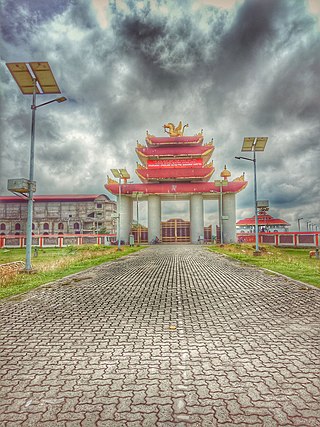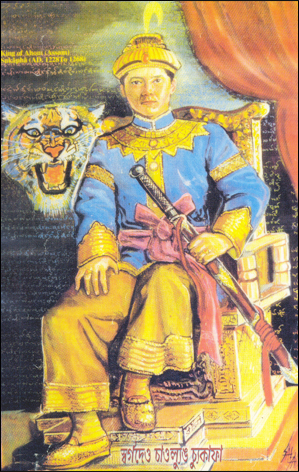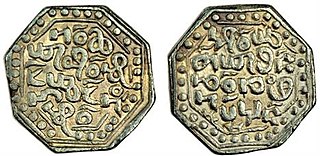
The Ahom, or Tai-Ahom is an ethnic group from the Indian states of Assam and Arunachal Pradesh. The members of this group are admixed descendants of the Tai people who reached the Brahmaputra valley of Assam in 1228 and the local indigenous people who joined them over the course of history. Sukaphaa, the leader of the Tai group and his 9000 followers established the Ahom kingdom, which controlled much of the Brahmaputra Valley in modern Assam until 1826.

The Ahom dynasty (1228–1826) ruled the Ahom Kingdom in present-day Assam, India for nearly 598 years. The dynasty was established by Sukaphaa, a Shan prince of Mong Mao who came to Assam after crossing the Patkai mountains. The rule of this dynasty ended with the Burmese invasion of Assam and the subsequent annexation by the British East India Company following the Treaty of Yandabo in 1826.

Sukaphaa, also Siu-Ka-Pha, the first Ahom king in medieval Assam, was the founder of the Ahom kingdom and the architect of Assam. A prince of the Su/Tsu (Tiger) clan of the Mao-Shan sub-tribe originally from present-day Mong Mao, Yunnan Province, China, the kingdom he established in 1228 existed for nearly six hundred years and in the process unified the various ethnic groups of the region that left a deep impact on the region. In reverence to his position in Assam's history the honorific Chaolung is generally associated with his name.

Suhungmung, or Dihingia Roja I was one of the most prominent Ahom Kings who ruled at the cusp of Assam's medieval history. His reign broke from the early Ahom rule and established a multi-ethnic polity in his kingdom. Under him the Ahom Kingdom expanded greatly for the first time since Sukaphaa, at the cost of the Chutia and the Dimasa kingdoms. He also successfully defended his kingdom against Muslim invasions, first by a general called Bar Ujjir and another by Turbak Khan. During his time, the Khen dynasty collapsed and the Koch dynasty ascended in the Kamata kingdom. His general, Ton-kham, pursued the Muslims up to the Karatoya river, the western boundary of the erstwhile Kamarupa Kingdom, the farthest west an Ahom military force had ventured in its entire six hundred years of rule.

The Ahom kingdom was a late medieval kingdom in the Brahmaputra Valley in Assam. It maintained its sovereignty for nearly 600 years having successfully resisted Mughal expansion in Northeast India. Established by Sukaphaa, a Tai prince from Mong Mao, it began as a mong in the upper reaches of the Brahmaputra based on wet rice agriculture. It expanded suddenly under Suhungmung in the 16th century and became multi-ethnic in character, casting a profound effect on the political and social life of the entire Brahmaputra valley. The kingdom became weaker with the rise of the Moamoria rebellion, and subsequently fell to repeated Burmese invasions of Assam. With the defeat of the Burmese after the First Anglo-Burmese War and the Treaty of Yandabo in 1826, control of the kingdom passed into East India Company hands.

Sukhrungphaa also Swargadeo Rudra Singha, was a Tungkhungia ahom king and 30th king of the Ahom kingdom who reigned from 1696 to 1714. Under whom the kingdom reached its zenith of power and glory, he is considered as the most illustrious of the Ahom kings. At Gadadhar Singha's death, his elder son Lai ascended the throne with the Ahom name of Sukharngpha and the Hindu name of Rudra Singha. He is best known for building a coalition of rulers in the region and raising a vast composite army against the Mughal Empire. He died on the eve of his march west from Guwahati. He had subjugated the Jayantias and the Kachari kingdoms in (1707). He built a new capital at Meteka and named it as Rangpur. Rudra Singha, following the words of his father, decided to reinstate the Vaishnava Gosain and Mahantas, he had settled the Satras in Majuli being nearer to the Ahom metropolis. He had received the initiation of Auniati Gosain, Haridev.
The Paik system was a type of corvee labour system on which the economy of the Ahom kingdom of medieval Assam depended. In this system, adult and able males, called paiks were obligated to render service to the state and form its militia in return for a piece of land for cultivation owned by the kingdom—believed to be a legacy the Ahoms brought with them from South-Eastern Asia in 1228. But it wasn't the Ahom kingdom alone that used a corvee system like this in Northeast India—Kingdom of Manipur and in a simpler form Jaintia kingdom and the Kachari kingdom too used similar systems that had tribal origins. The mature structure was designed by Momai Tamuli Borbarua in 1608, and extensively and exhaustively implemented by 1658 during the reign of Sutamla Jayadhwaj Singha. The system continued to evolve over time to meet the needs of the Ahom state and in time began to accumulate contradictions. By the end of the Moamoria rebellion (1769–1805) the Paik system had collapsed.
Borgohain was the second of the two original counselors in the Ahom kingdom. He was selected by the Ahom king from members of the Ahom nobility, who vowed not to fight for the position of Ahom kingship, rather act as a guide to the Ahom king in matters of administering his province in an efficient manner .The other original counsellor is the Burhagohain. Both the positions existed from the time of the first Ahom king, Sukaphaa. After the first major expansion of the Ahom kingdom, the Sadiya province was initially given to the Borgohain to administer. But later in the year 1527, he was replaced by King-lun Buragohain who was made Thao-mung Bo-ngen. After that, he was given the region south of the Dikhou river to Kaliabor on the south bank. In later times, he administered the region east of Burai on the north bank, as Borbarua was given the charge of territories between Sadiya province to Kaliabor.

Sunenphaa also, Pramatta Singha, was the king of Ahom Kingdom. He succeeded his elder brother Swargadeo Siva Singha, as the king of Ahom Kingdom. His reign of seven years was peaceful and prosperous. He constructed numerous buildings and temples. The most famous of his buildings was the Rang Ghar, which is also considered as the oldest amphitheatre in Asia.

Habung is a historical region in present-day Lakhimpur district of Assam, India, although some Tai-ahom activists claim it to be a part of present-day Dhemaji district. As per epigrahic records, Habung (Ha-vrnga-Vishaya) was a vishaya or province where Brahmins were settled by Ratna Pala of the Pala dynasty of Kamarupa in the 10th century.

The Chutia Kingdom was a late medieval state that developed around Sadiya in present Assam and adjoining areas in Arunachal Pradesh. It extended over almost the entire region of present districts of Lakhimpur, Dhemaji, Tinsukia, and some parts of Dibrugarh in Assam, as well as the plains and foothills of Arunachal Pradesh. The kingdom fell in 1523-1524 to the Ahom Kingdom after a series of conflicts and the capital area ruled by the Chutia rulers became the administrative domain of the office of Sadia Khowa Gohain of the Ahom kingdom.
Hazarika was a Paik officer under the administration of the Ahom kingdom and Koch kingdom. The commander over 1,000 (Hazar) paiks was known as a Hazarika. As it was a purely administrative position, the title holder could belong to diverse ethnic groups.

Suklenmung(1539–1552) was a king of the Ahom kingdom in medieval Assam. Since he established his capital at Garhgaon, he is also called the Garhgaiya roja in the Buranjis. It was during his reign that Madhabdev and Sankardeva's son-in-law Hari were captured and Hari executed, which precipitated the departure of Sankardeva from the Ahom kingdom.

Sudangphaa (1397–1407) was the king of the Ahom kingdom. He was popularly known as Bamuni Konwar because of his upbringing in a Brahman's house. His reign marks the first stage in the growth of Hinduism in the Ahom dynasty. He initiated the Singarigharutha ceremony of the Ahom kings, a tradition which was followed by his successors.

Susenphaa was the king of Ahom kingdom from 1439 CE to 1488 CE. Contemporary Ahom chronicles described him as a good king and the people under him were happy and prosperous. He ruled for a long period of 49 years. The only trouble which was recorded during his reign was the raids of Tangsu Nagas, which was dealt with the use of force, but not without losses.

Suhenphaa was the king of Ahom kingdom from 1488 CE to 1493 CE. His reign was characterized by the expansion of Ahom kingdom which resulted in conflicts with the Nagas and with the Kachari kingdom. He was successful in the military actions against the Nagas, while in case of Kacharis, he suffered defeat and had to sue for peace with the Kacharis. He was assassinated by one Ahom of Tairungban clan.

Supimphaa was the king of Ahom kingdom from 1493 CE to 1497 CE. In order to exact revenge on the murderers of his father Suhenphaa, he unleashed a reign of terror among people of both high and low ranks alike.

Sunyatphaa also Udayaditya Singha was the king of Ahom Kingdom from 1670 CE to 1672 CE. After his elder brother Swargadeo Chakradhwaj Singha died in the middle of Ahom-Mughal war, Udayaditya Singha succeeded to the throne. His reign witnessed the end of Ahom-Mughal war, which started during the reign of Chakradhwaj Singha, when the Mughal army led by Rajput prince, Ram Singh I of Amber, was decisively defeated by the Ahom forces led by Ahom commander Lachit Borphukan in the Battle of Saraighat. The later part of his reign was characterized by the failure of military expedition against the Dafala tribes and the influence of Paramananda Sannyasi, a saintly figure from Brindaban, over Udayaditya Singha. Udayaditya's over exerted devotion towards Paramananda Sanyasi, aroused dissatisfaction among the nobles, which ultimately caused his deposition and execution. His reign was followed by a series of political anarchy and internal disturbances in the Ahom kingdom which continued till the accession of Gadadhar Singha in 1681 CE.

The Chutia people are an ethnic group that are native to Assam and historically associated with the Chutia kingdom. However, after the kingdom was absorbed into the Ahom kingdom in 1523–24, the Chutia population was widely displaced and dispersed in other parts of Upper Assam as well as Central Assam. They constitute one of the core groups that form the Assamese people.

Ahomisation was an assimilation process in the former Ahom kingdom of Assam by which the people from different ethnic groups in the region became a part of what is now considered as the Ahom population.